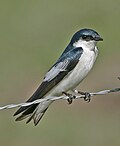| Tachycineta | |
|---|---|
 | |
| Tree swallow (Tachycineta bicolor) | |
| Scientific classification | |
| Kingdom: | Animalia |
| Phylum: | Chordata |
| Class: | Aves |
| Order: | Passeriformes |
| Family: | Hirundinidae |
| Subfamily: | Hirundininae |
| Genus: | Tachycineta Cabanis, 1851 |
| Type species | |
| Hirundo thalassina [1] Swainson, 1827 | |
| Species | |
see text | |
 | |
| Map includes former distribution in Jamaica | |
Tachycineta is a genus of birds in the swallow family Hirundinidae. There are nine described species all restricted to the Americas.
These are slender swallows with forked tails. Most species have a metallic green back, green or blue head, and metallic blue or unglossed brown wings. All have pure white underparts, and four species have a white rump.
Most Tachycineta swallows are at least partially migratory, with only golden and mangrove swallow being essentially resident. All the species use natural or disused cavities for nest sites.







